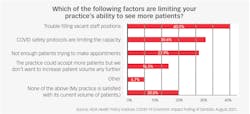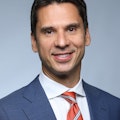The staffing shortage is limiting dentistry’s recovery. What's next?
COVID-19 hit dentistry with a force never felt before, not unlike the pandemic’s effect on other sectors and society as a whole. In March 2020, the New York Times identified dentistry as one of the highest risk occupations and settings for the spread of coronavirus.1 Nearly overnight, dental practices across the country closed their offices and sent their teams home. Employment in dentistry in April 2020 dropped to 44% of what it was in January 2020.2 Had it not been for the relatively swift action taken by Congress to implement measures such as the Paycheck Protection Program, which 92% of private practices took advantage of, employment likely would have plummeted even further.
But dentistry bounced back. The profession was undoubtedly well prepared to prevent the spread of disease as it applied, adapted, and amplified foundational concepts of infection control to keep patients and staff safe and get back to work.3 As the shutdown slowly eased up, the employment level in dental offices climbed back up to 90% of prepandemic levels by June and 100% by year’s end.2 As of the end of October 2021, dentistry boasts employment levels that exceed what they were prepandemic.2 Due to its resilience, dentistry is reaping the benefits of continued job growth.
Patient volume in practices must be following suit, now that we have just as many dental staff back in the office, right? Perhaps surprisingly, that is not the case. As of October 2021, patient volume in dental practices was at 90% of prepandemic levels, on average, nationally.4 There has been a consistent gap between employment level and patient volume since midway through 2020, where patient volume lags by at least 14% and up to 25% behind the employment level.4
Further reading: 5 reasons dentists retire 7 years later than the average American (and how to fix that)
Dentistry may have “fully recovered” in terms of employment levels—sheer numbers of employees in dental offices—but those employment numbers are no longer sufficient to meet the new demands of dental practice. Practices are short-staffed. Four out of 10 practice owners indicated that they were trying to recruit dental assistants, and nearly one-third were recruiting dental hygienists in August 2021.5 Almost all of these hiring dentists report significant challenges in filling the vacancies.5 These vacancies naturally reduce practice capacity, hindering practices’ abilities to accommodate patients with the same frequency as we saw leading into 2020. Staffing shortages have created a bottleneck in dentistry’s COVID-19 pandemic recovery (figure 1).Where has the dental team gone? As of August 2021, roughly 15 months into the pandemic, about 5% of hygienists who were employed prior to the pandemic still had not returned to work.6 The majority of these departures were voluntary, driven by concerns related to the ongoing pandemic or workplace safety.6 With widespread availability of COVID-19 vaccines and infection rates falling nationally, it would appear that a staffing rebound is imminent. Yet the dental hygienist shortage is likely to persist into next year. While some are slowly returning to work, a small number of hygienists who left the workforce when the pandemic began ultimately retired or left the profession permanently. This loss of experienced labor is not likely to be rapidly replaced by incoming hygienists, as first-year enrollment in dental hygiene programs in the fall of 2020 dropped by almost 7% compared to the previous year.7 Even if enrollment rebounds, it will be years before these new hygienists are qualified to enter the workforce.
The key challenges dental practices face in the near term all relate to staffing. Patients know dental offices are safe and are ready to resume “normal” life activities. So, now what? Practices need to think creatively not only about recruitment, but also staff retention. Are pay rates sufficient to compete with the many other hiring dentists in this new market? Is cross-training necessary as an interim solution to broaden skill sets on your existing team? Is this the time to promote skill flexibility and implement solutions such as teledentistry? Are there opportunities for professional development that promote a sense of workplace fulfillment, camaraderie, and growth? Does the staff know they are a critical link in the operation? The data makes this abundantly clear.
Labor shortage cycles take time to resolve. We will keep monitoring this in the months to come. At the American Dental Association, we’re looking forward to ongoing collaborations with colleagues in dental hygiene and dental assisting to better understand the complex issues at play. You will know how things are going in your own practice before hearing from us with the national perspective. Innovation will be needed; we’re just on the cusp of this workforce challenge in dentistry.
Editor's note: This article originally appeared in the January 2022 print edition of Dental Economics.
References
- Gamio L. The workers who face the greatest coronavirus risk. New York Times. March 15, 2020. https://www.nytimes.com/interactive/2020/03/15/business/economy/coronavirus-worker-risk.html
- Current employment statistics. U.S. Department of Labor, Bureau of Labor Statistics. https://www.bls.gov/ces/
- Araujo MWB, Estrich CG, Mikkelsen M, et al. COVID-2019 among dentists in the United States: a 6-month longitudinal report of accumulative prevalence and incidence. J Am Dent Assoc. 2021;152(6):425-433. doi:10.1016/j.adaj.2021.03.021
- COVID-19 economic impact on dental practices, week of October 11, 2021, results. ADA Health Policy Institute. https://www.ada.org/resources/research/health-policy-institute/impact-of-covid-19
- COVID-19 economic impact on dental practices, week of August 116, 2021, results. ADA Health Policy Institute. https://www.ada.org/resources/research/health-policy-institute/impact-of-covid-19
- Economic impact of COVID-19. Results for dental hygienists, week of August 16, 2021. ADA Health Policy Institute and the American Dental Hygienists’ Association. https://www.ada.org/resources/research/health-policy-institute/impact-of-covid-19/dental-hygiene-results
- Survey of Allied Dental Education, 2020-21. ADA Health Policy Institute. https://www.ada.org/resources/research/health-policy-institute/dental-education
About the Author
Chelsea Fosse, DMD, MPH
Chelsea Fosse, DMD, MPH, is a senior health policy analyst at the ADA Health Policy Institute, leading health policy analysis for critical issues related to Medicaid, Medicare, public health, the Affordable Care Act, and other public policy issues. She researches and analyzes policy changes that impact dentistry, oral health, and the health-care landscape as a whole. Dr. Fosse obtained her DMD from Rutgers School of Dental Medicine and her master's in public health from the Mailman School of Public Health at Columbia University.
Updated November 30, 2021
Rachel Morrissey, MPA
Rachel Morrissey, MPA, is a research analyst/educator at the ADA Health Policy Institute, responsible for the analysis/evaluation of data from annual dental school and allied dental program accreditation surveys. Previously she worked as a research consultant for several associations and nonprofits and was a survey specialist at the University of Chicago’s National Opinion Research Center. Morrissey received a master’s degree in public affairs from the University of Minnesota and a bachelor’s degree in economics from Macalester College in St. Paul.
Updated November 30, 2021
Marko Vujicic, PhD
Marko Vujicic, PhD, is the chief economist and vice president of the American Dental Association Health Policy Institute. He is a health-care policy thought leader and researcher focusing on providing data-driven insights on the future of dentistry. Contact him at [email protected].
Updated January 8, 2024




